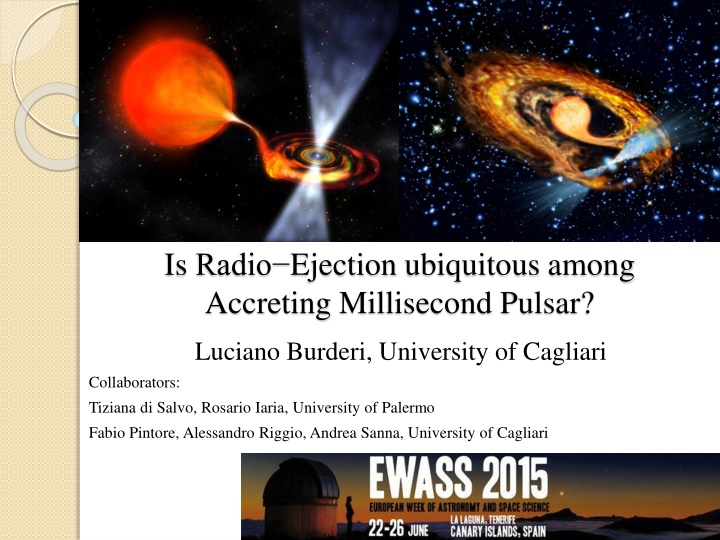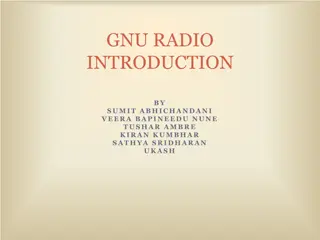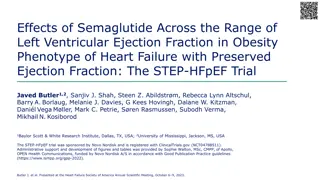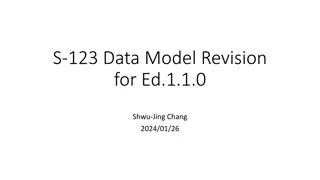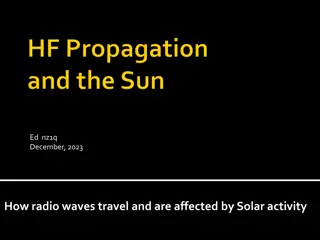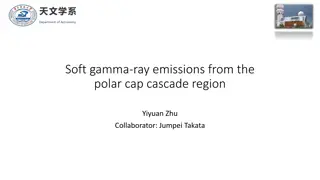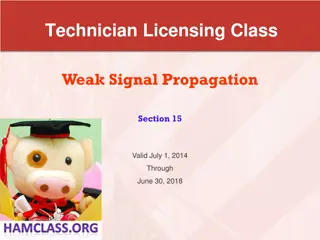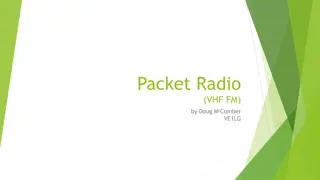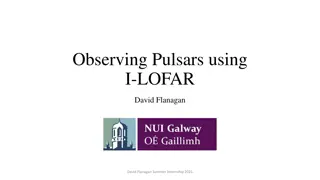Radio Ejection in Accreting Millisecond Pulsars: Evidence and Mechanisms
Investigating the phenomenon of radio ejection in accreting millisecond pulsars, this study explores the mechanisms behind this process and presents evidence from observations and theoretical models. Led by Luciano Burderi and collaborators from the University of Cagliari and University of Palermo, the research delves into the radio-ejection hypothesis, the orbital evolution of these pulsars, and specific case studies like IGR J1749.8-2921. The findings shed light on the intricate dynamics of these astrophysical systems.
Download Presentation

Please find below an Image/Link to download the presentation.
The content on the website is provided AS IS for your information and personal use only. It may not be sold, licensed, or shared on other websites without obtaining consent from the author.If you encounter any issues during the download, it is possible that the publisher has removed the file from their server.
You are allowed to download the files provided on this website for personal or commercial use, subject to the condition that they are used lawfully. All files are the property of their respective owners.
The content on the website is provided AS IS for your information and personal use only. It may not be sold, licensed, or shared on other websites without obtaining consent from the author.
E N D
Presentation Transcript
Is RadioEjection ubiquitous among Accreting Millisecond Pulsar? Luciano Burderi, University of Cagliari Collaborators: Tiziana di Salvo, Rosario Iaria, University of Palermo Fabio Pintore, Alessandro Riggio, Andrea Sanna, University of Cagliari
The Radio-Ejection mechanism (Burderi et al. 2001, ApJ) Pressure of a rotating magnetic dipole Magnetostatic (inside light cylinder): PMAG B2 r 6 Radiative (outside light cylinder) RAD 400 Hz: PPSR B2 4 r 2 PDISC dM/dt r 2.5 accretor PMAG B2 r 6 propeller dM/dt log p radio-ejector radio-ejector PPSR B2 4 r 2 Corotation Radius Light-cylinder Radius Roche-Lobe Radius log r (from NS center)
The Radio-Ejection hypothesis (Burderi et al. 2001, ApJ, Di Salvo et al. 2008, ApJ) Outburst: accretion episode Quiescence: radio ejection
Evidence of Radio-Ejection in Accreting Millisecond Pulsars Orbital evolution: q = m2/m1 dm2/dt < 0 (Secondary loses mass) dm1/dt = dm2/dt (conservative case, no mass loss from the system) Secondary star equation: (dR2/dt)/R2 = n (dm2/dt)/m2 (stellar index n = -1/3) Driving mechanism GR angular momentum losses: (dJ/dt)GR/JORB (32/5c5)(2 )8/3(Gm15/3)q(1+q)-1/3PORB 8/3 Angular momentum conservation: (dRRL2/dt)/RRL2 2 (dJ/dt)GR/JORB 2 (dm2/dt)/m2 (5/6 q) Accretion condition: (dRRL2/dt)/RRL2 = (dR2/dt)/R2 For q <<1 dm2/dt 1.5 m2 (dJ/dt)GR/JORB
Evidence of Radio-Ejection in Accreting Millisecond Pulsars IGR J1749.8-2921 (Papitto et al. 2011): PSPIN = 2.5 ms PORB = 3.8 h m2 0.17 MSUN (for m1 = 1.4 MSUN) or q3 f(m) (1+q)2/m1 (f(m) = m1sin(i)3q3/(1+q)2 orbital mass function) dm2/dt 1.5 m2 (dJ/dt)GR/JORB L = (Gm1/R1) ( dm2/dt) L (48/5c5)(Gm1)5/3(2 /PORB)8/3m11/3 f(m)2/3 (Gm1/R1) = LMIN LAVERAGE = LOUT ( tOUT/ tTOT) decreases if the source is still in quiescence after the first outburst If LAVERAGE << LMIN conservative evolution is IMPOSSIBLE!
Evidence of Radio-Ejection in Accreting Millisecond Pulsars LMIN
Results from timing of 5 outburst of SAXJ1808.4- 3658 (1998 2015) Delays of the time of ascending node passage of all the outbursts show a clear parabolic trendwhich implies a costant dPORB/dt, more than 10 times what is expected by conservative mass transfer from a fully convective and/or degenerate secondary (n -1/3) driven by GR (Di Salvo, 2008; Hartman, 2008) ! Orbital period increases: dPORB/dt = (3.89 0.15) 10-12 s/s 2015 Burderi et al. 2009 using XMM and RXTE 2011 2008 2005 2002 19982000
Theory of Dynamical (Orbital) evolution in SAXJ1808.4-3658 Following Di Salvo et al. (2008): a) JTOT conservation; b) third Kepler's law; c) AM losses by GR; gives the orbital period derivative: 2 ( ) 2/3q1/3 For matter ejected at L1a = 1-0.462 1+q 0.7 (for m2=0.08) g(b,q,a)=1-bq-(1-b)(a +q 3) (1+q)=0.32 (for b =1)
Predictions from Secular evolution Following Di Salvo et al. (2008) we adopt: a) JTOT conservation; b) contact condition: and c) MB and GR angular momentum losses as driving mechanism Highly non conservative mass-transfer is required by the Secular evolution to drive the high mass-transfer rate implied by the Dynamical evolution!
Explaining the large observed dPORB/dt Hartman et al. (2008) and Patruno et al. (2011) proposed that magnetic activity in the companion is responsible for the orbital variability of SAXJ1808 as discussed by Applegate & Shaham (1994) and Arzoumanian et al. (1994) to explain the orbital varability observed in PSR B1957+20 and predicted that quasi-cyclic variability of PORB would reveal itself over the next few years, but t 70 s Parabola T 17 yr PMOD 68 yr ? t 3.8 s Sinusoid PMOD 6 yr Arzoumanian et al. (1994)
The Applegate & Shaham model for periodic orbital modulations In the model of Applegate & Shaham (1994) variations of the quadrupole moment, Q, of the secondary istantaneously reflect (through the action of gravity) in PORB: Q varies because of AM transfer between (internal) shells of the secondary caused by the action of a strong (internal) magnetic field. This mechanism has a cost: the internal energy flow required to power the action of the magnetic field is (assuming a Roche Lobe filling secondary) : 2/3m2 ( ) q -2/3DPORBPORB ( )-7PMODerg/s dE dt =1.6 10321+q 5/3P2h
Energy constrains in the Applegate & Shaham For PSR B1957+20 a sinusoidal modulation is observed with PORB 9.17 h, P/P 1.0 10-7, PMOD 6 yr, m1 = 1.4, m2 = 0.025. For SAXJ1808.4-3658 no sinusoidal modulation is observed, although is possible to believe that what we observe is part of a sinusoid with PORB 2.01 h, P/P 72 10-7 and PMOD 70 yr, m1 = 1.56, m2 = 0.08. This gives: dE/dt 3 1030 erg/s = 7.5 10-4 LSUN (PSR B1957+20) dE/dt 8 1032 erg/s = 0.1LSUN (SAXJ1808.4-3658)
The tidal-dissipation Applegate & Shaham mechanism For small secondaries the internal energy flow required to power the action of the magnetic field (dE/dt) cannot come from nuclear burning since L = m25 LSUN and: M2 0.025 MSUN M2 0.080 MSUN (PSR B1957+20) (SAX J1808.4-3658) Applegate & Shaham (1994) argued that the required power is provided by tidal dissipation in a sligthly asynchronous secondary ( / 10-3). Tidal power proportional to (RRL2/R2)9: drop vertically as R2 RRL2 The secondary is kept out of perfect corotation by the magnetic braking action of a strong stellar wind. This mechanism operates in PSR B1957+20 because the companion underfills (80-90%) its Roche Lobe. On the other hand, the companion of SAXJ1808.4-3658 fills its Roche Lobe, as testified by the accretion episodes, thus tidal dissipation cannot wok to power the Applegate & Shaham mechanism in this source.
Explaining the 7s delay observed in the 2011 outburst a) Some degree of asynchronism could drive a tidal-dissipation Applegate & Shaham mechanism with orbital oscillations of few seconds amplitude. The power required is 10 3 10 4 times less than the power required to produce the main (parabolic) modulation: dE/dt 1029 1030 erg/s. b) The mass outflow induced by Radio-ejection is highly variable up to 30 40% in line with the observed peak bolometric luminosity variations (see right panel below). Since dPORB/dt dm2/dt these variations induce dPORB/dt variations of the same order. 2011 2002 t 3.8 s Sinusoid PMOD 6 yr 1998 2015 2005 2008 2000 Arzoumanian et al. (1994)
Conclusions Radio-ejection is a necessary outcome if accretion onto a rotating magnetic dipole drops moving the truncation radius of the disc beyond the light cylinder. Accreting Millisecond Pulsar are Transient: the onset of radio ejection during quiescence is likely. Conservative orbital evolution driven by GR is excluded at least in IGR J1749.8 2921. The large orbital period derivative detected in SAXJ1808.4 3658 implies a high average mass transfer rate not compatible with a conservative scenario. The tidal-dissipation Applegate & Shaham mechanism that produces quasi-sinusoidal orbital period modulation works in PSR B1957+20 because the companion underfills its Roche Lobe and asinchronous dissipation is possible. The companion of SAXJ1808.4-3658 fills its Roche Lobe, and tidal dissipation cannot wok to power the Applegate & Shaham mechanism in this source. The tidal-dissipation Applegate & Shaham mechanism could explain the small discrepancy observed during the 2011 outburst (7s) that is comparable to the orbital Fluctuations observed in PSR B1957+20. Alternatively, fluctuations of the mass outflow induced by the onset of Radio-ejection are proportional to fluctuations in dPORB/dt
Thats all Folks! Thank you for your attention
